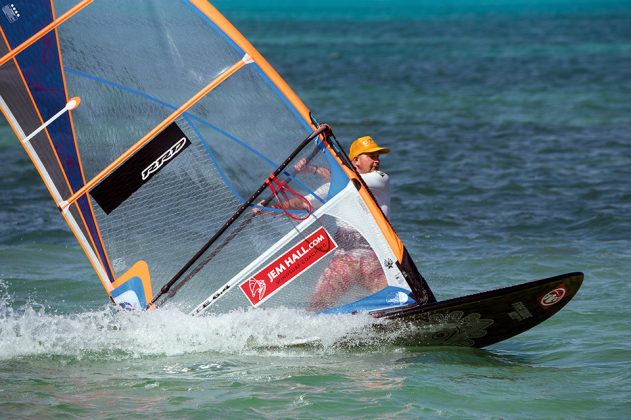JEM HALL
MOVE ON UP – WINDSURFING TECHNIQUE
CARVE THAT UPWIND 360
Let’s keep you busy, inspired and challenged. Building upon your heli. tacks, the Upwind 360 is a fantastic progression to work towards. It also slips into the Magical Moves that matter in the Carving Freestyle category.
Words Jem Hall // Photo Nicolas Jones
www.jemhall.com
(This feature originally appeared in the July 2016 issue of Windsurf Magazine. To read more features like this first, Print and Digital subscriptions are available. Prices include delivery globally for 10 x issues a year!)
I often ask people that I coach to focus on hitting the right moves, at the right time and at the right place. So look to squeeze the planing version of this move in when you have some nice flat water and planing winds but not too much power. Light wind practice is vital to nail the subtle parts of this ‘front to sail’ steering move. ‘Why am I doing this coach?’ I hear you cry. Well, it will improve your carving and many other skills, and it will also help your backside waveriding. Plus it is the cornerstone for lots of sliding freestyle moves.
The Progression
As for many moves, I have a suggested pathway to follow in order to achieve overall success and hit some key targets on the way, all whilst enjoying the journey. Yet again I implore you to get up and get out there in light winds to acquire some vital skills. Check out the Heli. tack page on my website to see just how many light wind moves we can achieve! Let’s look at the pathway to success –
• Light wind skills: building on your Heli. tacks, when you have stability front to sail, now it is time to focus on the sail opening and steering downwind part, followed by punching the sail out to finish off your Upwind 360’s.
• Carving it up: for me this is the crux of the planing Upwind 360. You need to be smooth as you carve upwind off your front foot, keeping speed and looking to maintain a flat board in readiness to be in the best position for the front to sail steering.
• Going for the whole move and enjoying the journey. There is a lot to focus on so keep it simple and just concentrate on a few targets in every attempt. Build it up and know you can, shall and will succeed.
Build it up
Working on the finer points of the upwind 360 in light winds will give you the time to appreciate the subtlety it requires and also appreciate that working on simple targets will really help you nail it.
You should have the steering the board through the wind skills down, and already felt a ‘light bulb’ moment in the heli tack when if you open the sail and shift the rig forward and towards the wind then the board bears away, and so now all you do is hold this front to sail steering position until the tail passes through the eye of the wind. Again I ask you to ‘don’t think, but feel’ this part of the move. Once you are through to the new direction you reverse everything to bring the sail back upright and into the sailing position, this involves you pushing out on the backhand, pulling in the front hand and a good dose of ‘Get Down, James Brown’ as you weight your heels. That is the mechanics of the whole slower speed upwind 360, and there really is too much to describe for any more detail, so let me give you the main front to sail steering tips –
• Look: I mean really look over your front shoulder to twist your shoulders and your hips, and help you steer.
• Steer: taking a wider stance will exacerbate your steering as you pull with the front foot and push with the back foot.
• Extend & bend: get the rig away on a straight front arm to speed up the steering (think front to sail gybe) and bend your back arm (think thumb in ear) to depower the sail and avoid stalling it.
• Flow: you know you have it (front to sail control) when you can drop your front hand as then you are definitely keeping your back arm pulled in, and steering effectively.
Some finishing tips are to really be aggressive as you bring the rig upright, and really look upwind. If the sail is powering up quick, or you are too slow to react, then just let go your backhand and drop low.
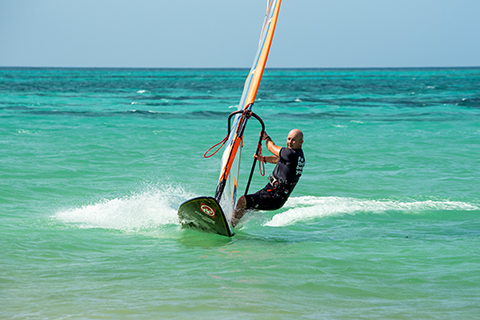
Carve it up, rig back and body moving forward.
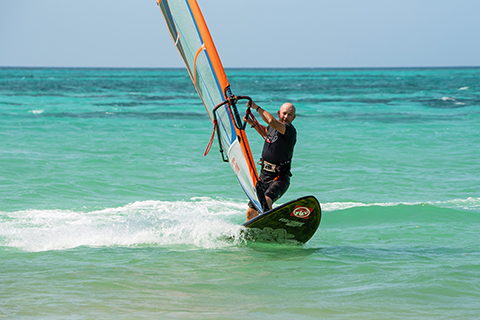
Bring rig forwards and across as you move inboards.
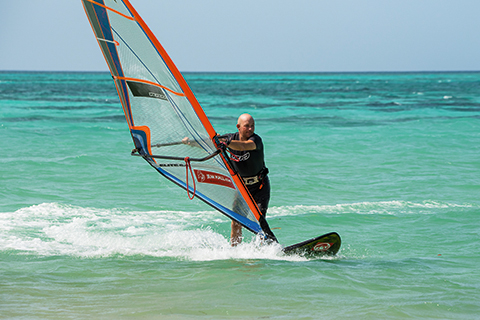
Flatten the board and weight toes as you keep sweeping rig forwards.
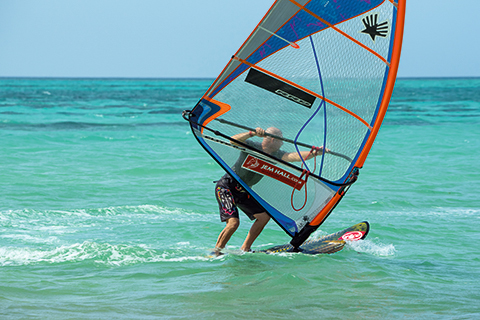
Look, lean, open and steer with the thumb in your ear.
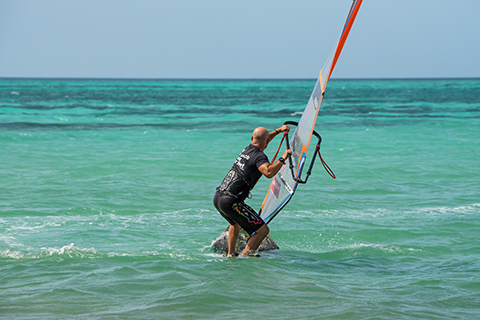
Patience as you keep steering with the rig kept in.
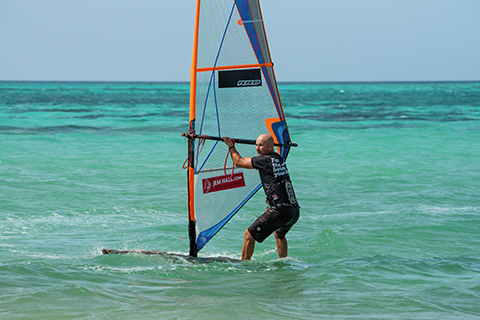
All change as you drop low over your heels and punch out on the back hand
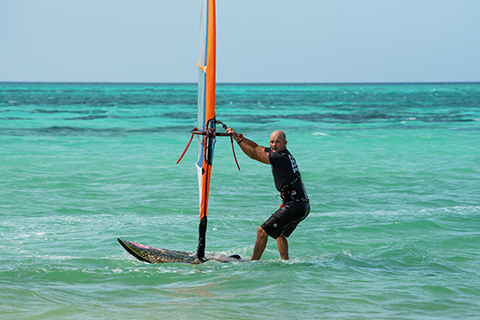
Finish it with a good look up and out, as you sheet out further and flatten the board.
Carve it up
This move is like the downwind 360 in that the smoother your carving and the further you get, the less you have to do, which means fewer front to sail shenanigans when powered up. So it is really worth getting good at the
carving upwind part so that you can get as far through the wind as possible as then you can arrive at this point with a flat board and in a stable position to transition across into the front to sail steering part. Here are some tips:
• You are doing this move powered up but not excessively so. Therefore if the wind is a bit too light, or your speed a bit low, then bear away a little bit to get your speed up so you can work with your board’s rail.
• Have your hands relatively close together and unhook smoothly in order to keep speed.
• Carve the board gradually, in both straps and from an outboard position. Just like in a carve 360, you begin the carve off the front foot, with gentle pressure and then increase it through added heel pressure.
• Look upwind and as the rig goes back move the body forwards and inboard while the sail remains sheeted in.
Get very good at the carving phase so as to help you get this move but also so that your backside waveriding progresses too.
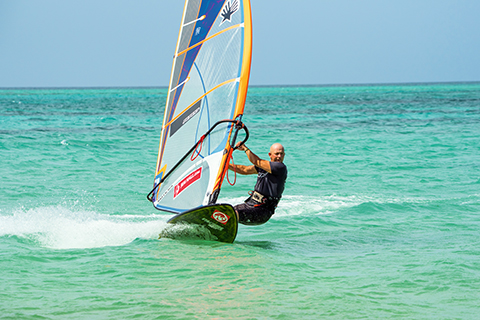
‘Carve upwind progressively with the body moving forwards and out as the rig moves back.
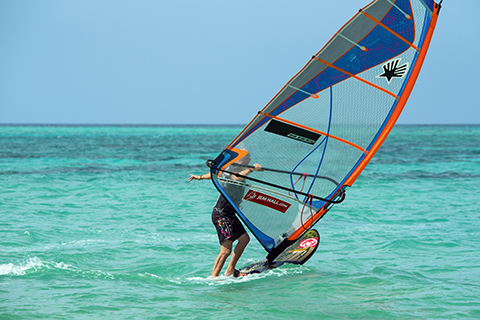
‘Being able to drop your front hand means you have understood how to depower the sail and steer effectively.’
The Whole move
You have now been equipped with many skills and tips in order to place you in the best position to work on completing the whole move, so let’s look at this in its entirety now:
1. Carve on your heels and look upwind with the body moving forwards and in as the rig moves back.
2. The board has now passed through head to wind, and it’s time to continue moving forwards and in with your weight now repositioning to bring youover the board. You are now coming over onto your toeside in readiness to go front to sail. Start to draw the rig forwards and across you.
3. Keep looking upwind as you slide the backhand way down the boom as you begin to guide the rig forwards and across you. Get plenty of weight over the front foot, and toes, so as to get the board flat and ready to steer.
4. Dip the mast into the wind, as it is now time to use your entire front to sail steering skills, and remember to really pull in on the back arm. I aim to get my thumb almost poking into my ear.
5. As you are now about to pass through downwind, be patient and keep steering through your feet! Continue to look round over your front shoulder with the back arm still pulled in. The weight change is about to come.
6. All change please as you punch the sail out with the back arm and bring the mast upright by pulling your front arm in. Get the sail fully sheeted out to stop the rig powering up. The body will move outboard and over the backfoot and your heelside to resist the sail’s power and help to slide the board around.
7. Really concentrate on looking upwind here to spill any last power. You can keep the tail from sinking by moving your head towards the mastfoot, and by pulling down on your front foot and arm.
Finally, I’ll leave you with these inspirational words from Michael Jordan – ‘Don’t be afraid to fail. Be afraid not to try.’
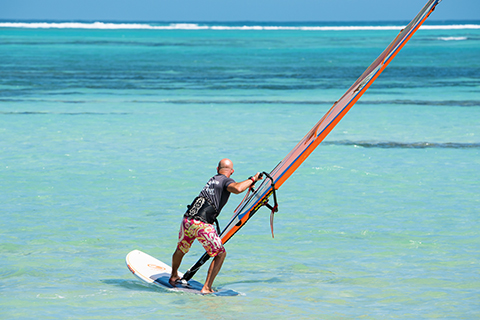
‘Crack the move in light winds on a big board and build on your front to sail skills!’
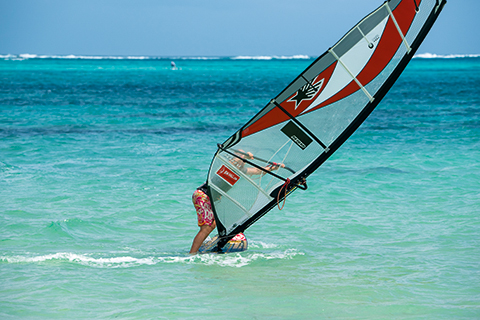
‘With a flat board and sail open you will be in control and able to steer through the wind smoothly.’
Kit:
Small freemove board, or large FSW, with a smaller fin to help it carve. More volume means more speed carried through the carve and less tail sinking at the end. Generous straps to allow you to carve the board hard and ease the transition from heelside to toeside. A flat sail will make the sail more controllable throughout front to sail and also the exit/punching out phase.
Conditions:
Flat water, medium wind and powered up but not too powered up.
“ Light wind practice is vital to nail the subtle parts of this ‘front to sail’ steering move ”
RRD boards, wetsuits, softwear, Ezzy sails and Pro Sport Sunblock sponsor Jem Hall. Get him live and direct on one of his highly acclaimed coaching holidays. You can also follow him on twitter / Facebook and Instagram.
www.jemhall.com


